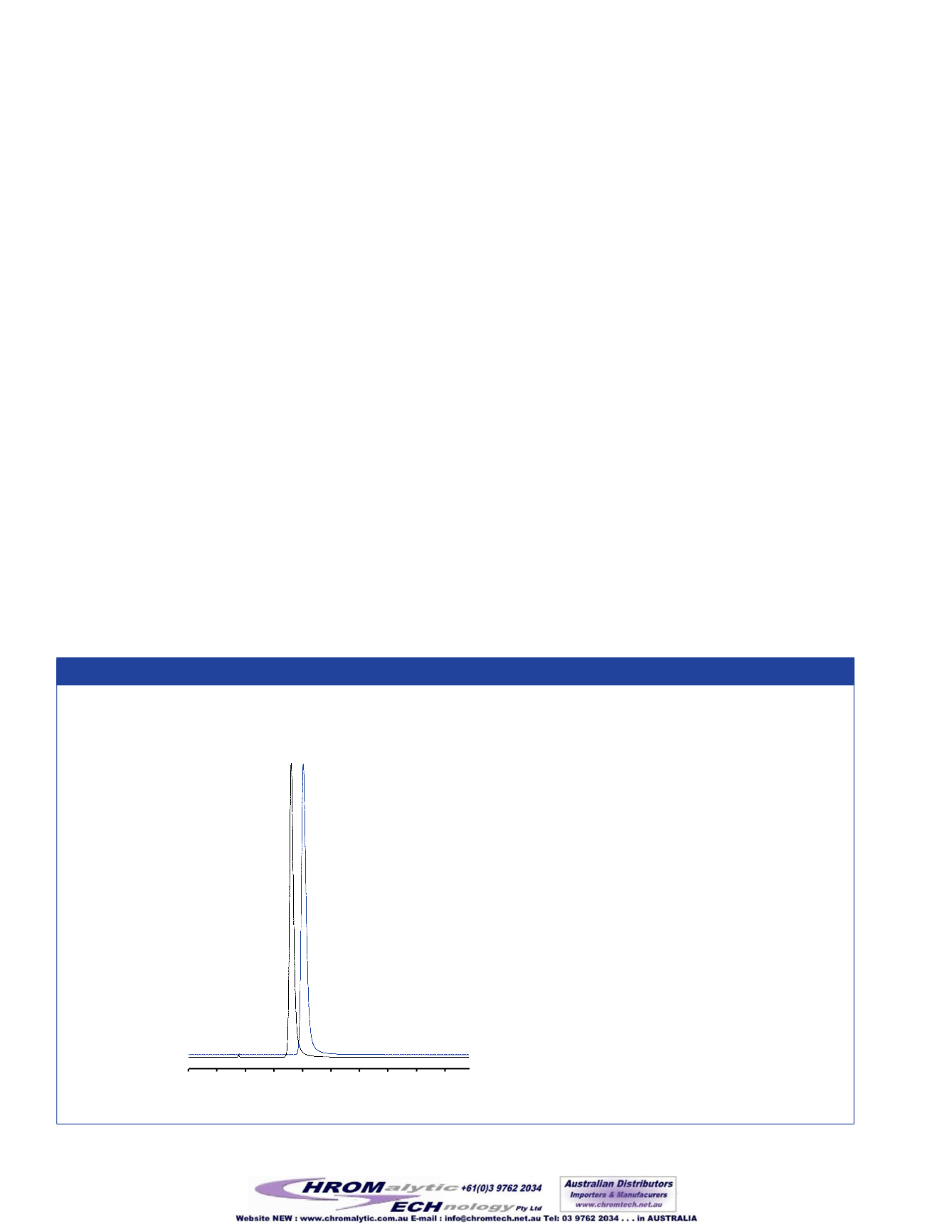
RestekCorporation • (800)356-1688 • (814)353-1300 •
Figure2
Both normal and reverse phasemodes provide good peak shape and retention time onUltra IBD column.
0 1 2 3 4 5 6 7 8 9 min.
Column:
Ultra IBD, 5µm, 4.6mm x 150mm,
100 Å (cat.# 9175565)
Mobile Phase:
Reverse Phase
20mM Ammonium Acetate, pH
4.0:Acetonitrile (80:20)
Normal Phase:
20mM Ammonium Acetate, pH
4.0:Acetonitrile (20:80)
Inj.:
5uL, 1.0mg/mL Cephaloridine
Det.:
254nm
Temp.:
27°C
A B
Peak List:
A. Cephaloridine in
Reverse Phase Mode
B. Cephaloridine in
Normal Phase Mode
By contrast, the Ultra IBD column reaches a minimum
retention time at 50% acetonitrile, closely duplicating the
hydrophobic interactions of the C18 column. As the organic
ratio increases above 50%, polar interactions in the normal
phase mode allow retention of the cephaloridine analyte.
The retention of cephaloridine reaches a usable maximum at
90% acetonitrile. Furthermore, the U-shaped retention
profile is not adversely altered by the pH of the buffer. The
separation is a near mirror image across the reverse phase
and normal phase modes. Only at the extreme of 90%
acetonitrile is a small variation seen in analyte retention due
to pH changes. Even then, the variation is less than 2.8
minutes at pH 7.4. The normal phase retention is greater than
the reverse phase retention. Both modes, however, provide
similar peak shape and retention time (Figure 2).
Note: As with any HPLC column phase capable of perform-
ing a reverse or normal phase separation, the user should
take care to ensure the retention mechanism is either reverse
or normal phase.
Ultra IBD Column Solvent Focusing Ability Improves
Detection
Loading multiple samples onto the head of the column
concentrates the analyte to improve detection. The injec-
tions are then eluted through the system using a decreased
solvent level ratio. This ability to load and maintain a
sample at the column head is called solvent focusing.*
When cephaloridine was injected with a mobile phase of
either 100% acetonitrile or 100% buffer, no peak eluted from
the system—even after 90 minutes. To elute the analyte from
the system, the mobile phase ratio was altered to 80%. The
peak then eluted near its isocratic run time. Cephaloridine
remained intact near the start of the column and did not
begin appreciably eluting through the column until another
mobile phase ratio was selected.
Due to its solvent focusing capabilities, an Ultra IBD column
can be loaded at either the 100% aqueous (reverse phase) or
100% organic (normal phase) solvent level to concentrate
the sample directly onto the head of the column.
Furthermore, this solvent focusing capability allows use of a
gradient system to better remove impurities from a sample
mixture that have adsorbed onto the column. More hydro-
philic impurities theoretically could be eluted from the
analytes of interest with a simple aqueous flush. The process
could be reversed using 100% organic for truly neutral
analytes.
* The ability to perform solvent focusing will be affected by
the chemical nature of the analyte.
Conclusion
The unique functionality of the Ultra IBD column creates an
ideal tool for the separation and detection of acids, bases,
and zwitterions within complex mixtures. Because the phase
interactions are bimodal, a wide range of compounds can be
retained and separated by either reverse or normal phase
mechanics. At the extreme range of the reverse or normal
modes, the solvent focusing ability of the Ultra IBD column
can be used to concentrate an analyte or to purify analytes
within complex matrices.
See back for product listing.
Application notes: LC-0101&LC-0102


